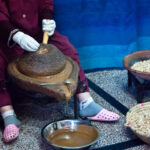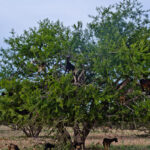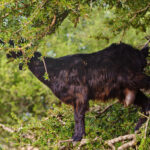7 Incredible Natural Phenomena you’ve never seen
Published on 11/16/2007 under Weird Science –
“Morocco’s Climbing Goats
Goats on trees are found mostly only in Morocco. The goats climb them because they like to eat the fruit of the argan tree, which is similar to an olive. Farmers actually follow the herds of goats as they move from tree to tree. Not because it is so strange to see goats in trees and the farmers like to point and stare, but because the fruit of the tree has a nut inside, which the goats can’t digest, so they spit it up or excrete it which the farmers collect. The nut contains 1-3 kernels, which can be ground to make argan oil used in cooking and cosmetics. This oil has been collected by the people of the region for hundreds of years, but like many wild and useful things these days, the argan tree is slowly disappearing due to over-harvesting for the tree’s wood and overgrazing by goats.
As a result a group of people and organizations have banded together to try to save the tree. To do so one of the primary locations where the trees grow has been declared a biosphere preserve. It was also decided that by making the world aware of the oil, it’s great taste and supposed anti-aging properties, would create a demand for it. However, the people who planned to market the oil could not envision people wanting to put an oil on their food or their face that was collected from goat excrement. As a result, a campaign is being led to ban grazing on the trees by goats during certain parts of the year to allow the fruit to ripen and fall off on its own. The fruit is then collected and turned into oil by oil cooperatives.”
I was just there, and the coop seem to be working. Most argan sold today is produced by a Berber women’s cooperative that shares the profits among the local women earning money which provides health and education to them and the whole community. The cooperative has established an ecosystem reforestation project so that the supply of argan oil will not run out and the income that is currently supporting the women will not disappear. The goats are kept out of the trees from May to August thus the trees are looking much healthier than the pictures of trees taken in 2007.
According to the Department of Water and Forests, Argan oil provides income for 3 million people in the southern part of the kingdom. The oil provides a total of 20 million workdays per year. Its operation is an income-generating activity and has always had a socio-economic function.
Co-sponsored by the Social Development Agency (SDA) with the support of the European Union, the UCFA (Union des Cooperatives des Femmes de l’Arganeraie) is the largest union of cooperatives for argan in Morocco. It comprises twenty-two cooperatives that are found everywhere in the region (e.g., Coopérative Al Amal, Coopérative Amalou N’Touyag, Coopérative Tissaliwine, Coopérative ArganSense, Coopérative Maouriga). These women come together to be better organized and thus guarantee a fair income through cooperatives, allowing them a better living environment.
Argan oil is an oil produced from the kernels of the argan tree, endemic to Morocco, that is valued for its nutritive, cosmetic and numerous medicinal properties. The tree, a relict species from the Tertiary age, is extremely well adapted to drought and other environmentally difficult conditions of southwestern Morocco. The species Argania once covered North Africa and is now endangered and under protection of UNESCO. The Argan tree grows wild in semi-desert soil, its deep root system helping to protect against soil erosion and the northern advance of the Sahara. This biosphere reserve, the Arganeraie Biosphere Reserve, covers a vast intramontane plain of more than 2,560,000 hectares, bordered by the High Atlas and Little Atlas Mountains and open to the Atlantic in the west. Argan oil remains one of the rarest oils in the world due to the small and very specific growing areas.
Before modern times, the Berbers (also known as the Amazighs) of Morocco would collect undigested Argan pits from the waste of goats which climb the trees to eat their fruit. “Amlou” a thick brown paste with a consistency similar to peanut butter is produced by stone grinding roasted almond and Argan oil and is considered a favorite local bread dip. However, the oil used in cosmetic and culinary products available for sale today has most likely been harvested directly from the tree and processed with machines. The unroasted oil is traditionally used as a treatment for skin diseases, and has found favour with the cosmetics industry.













2 replies on “Goats who Climb Trees”
Lili’s retired. Last national show was with Carmen in Detroit and I got to see opening night. It was absolutely perfect in all aspects not just Lili’s dancing.
She’s providing palmas and castanets for flamenco Christmas songs (Villancicos). If you find yourself in Santa Fe this Sat. We’ll be at the Museum Cafe (Museums on the Hill) from 11:30 to 2:00 with a singer, Nicolasa Chavez and another guitarist. We’re coming out with a CD of it-may have a short, 7 song, demo for sale but haven’t seen it in the mail yet. Ciao 4 niao, Lew
Merry Christmas Lew & Lilli,
Sorry we missed you at Museum Cafe, we had an HD Opera at the Lensic.
Let me know when your CD is out.
Doris